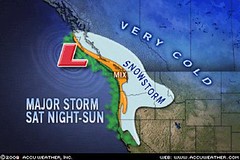 Solar eclipses are known to have about a 3 year "life span." For long-range weather forecasting, this means that, within that 3 year or so period, outer planets can trigger the eclipse and the atmosphere will react according to the influence of the planets involved in the activation.
Solar eclipses are known to have about a 3 year "life span." For long-range weather forecasting, this means that, within that 3 year or so period, outer planets can trigger the eclipse and the atmosphere will react according to the influence of the planets involved in the activation.The Weather Alternative issued a forecast 3 months ago on September 23rd noting that the solar eclipse of March 18th, 2007 would be triggered on December 19th by the Last Quarter Moon. The forecast stated that "This may trigger a storm system or front over western Canada and pushing into the Pacific Northwest. After the 21st temperatures should increase over the mid-Atlantic states leading to storms."
The Accuweather map above, shows the storm hitting Canada and the Pacific Northwest. Accuweather calls it a major storm which will easily bring several inches of snow to Seattle by Sunday night and 1 to 2 feet of snow for the mountains.
 Stormy conditions were also mentioned in the forecast for the mid-Atlantic area after the 21st. There will be no increase in temperatures before the storm, however. Accuweather is calling for three to six inches of snow to accumulate in southern New York state and northern Pennsylvania, especially in the higher elevations. The weather will deteriorate by Sunday morning (Dec 21). Then bitterly cold air will also pour in after the storm, leading up to the holiday.
Stormy conditions were also mentioned in the forecast for the mid-Atlantic area after the 21st. There will be no increase in temperatures before the storm, however. Accuweather is calling for three to six inches of snow to accumulate in southern New York state and northern Pennsylvania, especially in the higher elevations. The weather will deteriorate by Sunday morning (Dec 21). Then bitterly cold air will also pour in after the storm, leading up to the holiday.
The Weather Channel explains that "As one storm system weakens around the Great Lakes, another one will form off the Middle Atlantic Coast and will move northeastward and intensify as it makes quick time toward the Canadian Maritimes."
Solar Eclipse Activation Fall 2008 Part 1
Introduction to the Weather Alternative
How Long-Range Forecasts Are Made
Saint Nick
Nicholas was born of wealthy parents in A.D. 280 in the village of Patara. At the time the area was Greek, and is now on the southern coast of Turkey. He lost his parents early to an epidemic, but not before they had instilled in him the gift of faith. Then Nicholas went to Myra and lived a life full of sacrifice and love and the spirit of Jesus. Nicholas became so Christlike that when the town needed a bishop, he was elected. He was imprisoned for his faith by Emperor Diocletian and released later by Emperor Constantine.
There have been many stories of his generosity and compassion: how he begged for food for the poor, and how he would give girls money so that they would have a dowry to get a husband. The story most often repeated was about how he would don a disguise and go out and give gifts to poor children. He gave away everything he had, and he died around 345. His body was later moved to Bari, Italy, where his remains are to this day.
But the story of Nicholas has spread around the world. Within a century of his death he was celebrated as a saint. There are more churches in the world named after St. Nicholas than any other person in the history of the church.
People have also done strange things to him. Poet Clement Moore gave him a red nose and eight tiny reindeer. And Thomas Nast, the illustrator, made him big and fat and gave him a red suit trimmed by fur. And others have given him names, like Santa Claus. But what’s important about St. Nicholas is that he had the mind of Christ. Because of his gentle, selfless love, he touched the whole world. And this same mind of Christ can be in us.—James Hewett
No comments:
Post a Comment